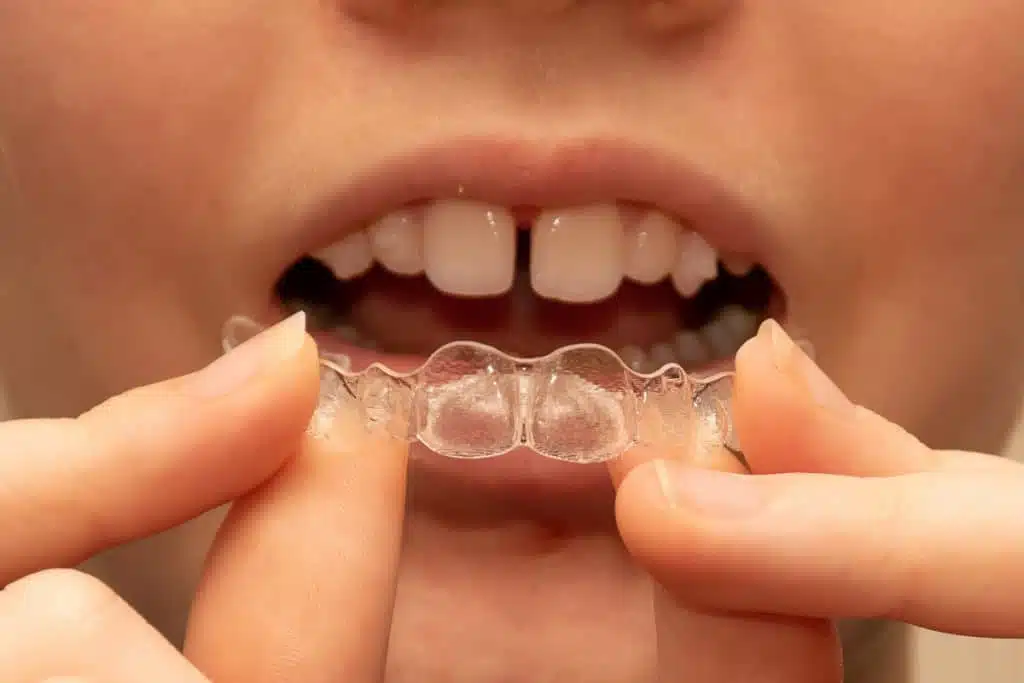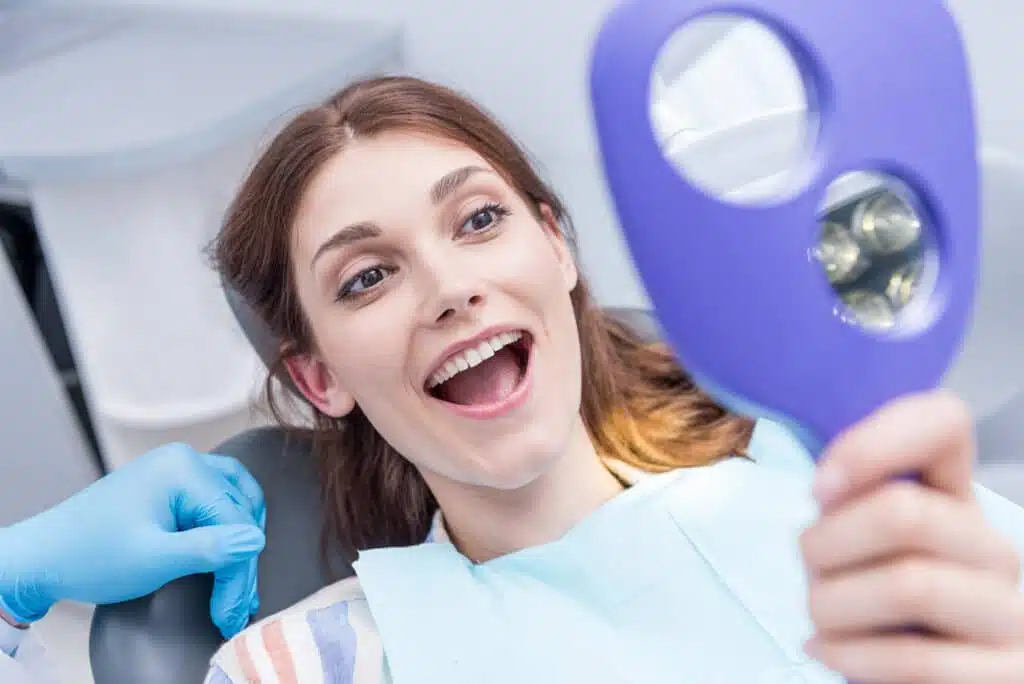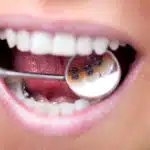Aligners enable discreet tooth correction and are becoming increasingly popular. But how does Invisalign actually work and what are the advantages of the treatment?
Invisalign is an innovative method of correcting misaligned teeth that offers an alternative to traditional braces.
Unlike traditional metal braces, Invisalign are transparent and barely visible. They offer patients a discreet way to correct their teeth while living a life without restrictions.
In this article, we will take a closer look at how Invisalign braces work and the benefits of this revolutionary technology.
| Get 150 € discount on your dental correction! |

Book a consultation appointment now at a nearby DrSmile partner practice and find out if teeth straightening with aligners is right for you.
The appointment is completely non-binding and does not involve any costs.
With the code “THATSMILE150” you will receive 150 € discount on the treatment.
How does Invisalign work and what is it exactly?
Invisalign is an advanced system for correcting misaligned teeth based on clear aligners.
These aligners are made individually for each patient and must be changed regularly to achieve the desired results.
Compared to traditional braces, Invisalign offers a number of advantages.
What are the advantages of Invisalign?
Invisalign offers a number of advantages over traditional braces. Here are some of the main advantages at a glance:
1. aesthetic advantages
Invisalign are transparent and barely visible, making them an aesthetically pleasing option.
Unlike metal braces, patients do not have to worry about their appearance while correcting their teeth.
2. comfort and convenience
Invisalign are made of a soft, smooth plastic material that is comfortable to wear in the mouth.
Unlike metal braces, which can cause pressure and friction, Invisalign are comfortable to wear.
3. better oral hygiene
Unlike traditional braces, Invisalign can be removed for eating and cleaning teeth.
You can drink with Invisalign – but ideally only water and unsweetened, non-staining drinks.
This allows for better oral hygiene, as teeth can be brushed easily and even floss can be used.
4. no restrictions on the diet
With Invisalign patients can enjoy their favorite foods and drinks because the aligners are simply removed before eating.
In contrast, traditional braces require restrictions on certain foods to avoid damage.

How does Invisalign work?
The way Invisalign works is based on the use of custom-made aligners.
These aligners are a series of transparent plastic splints that gradually correct the position of the teeth.
Treatment with Invisalign takes place in several steps:
- Consultation and treatment planning: The first step is to see a specialist for a consultation. The doctor will examine the condition of the teeth and prepare an individual treatment plan.
- Fabrication of the aligners: Based on the treatment plan, the aligners are fabricated individually. Each aligner is designed for a specific phase of treatment and must be changed approximately every two weeks.
- Wearing the aligners: The patient wears the aligners for a large part of the day, usually at least 22 hours. The aligners are almost invisible and do not interfere with daily life.
- Regular adjustments and follow-up visits: Regular follow-up visits with the physician are made during treatment to monitor progress. New aligners are fitted at each visit to achieve the desired tooth shift.
| Get 150 € discount on your dental correction! |

Book a consultation appointment now at a nearby DrSmile partner practice and find out if teeth straightening with aligners is right for you.
The appointment is completely non-binding and does not involve any costs.
With the code “THATSMILE150” you will receive 150 € discount on the treatment.
Who is a suitable candidate for Invisalign?
Invisalign can be used for a wide range of misaligned teeth. The system can be used, for example, to correct crowding, gaps between teeth, crossbites, overbites and underbites.
However, there are some factors that must be considered to determine if a patient is a suitable candidate for Invisalign.
Not all malocclusions can be corrected with Invisalign, especially very severe cases of malocclusion.
A specialist can best assess whether Invisalign is suitable for a particular case.
How does Invisalign work compared to traditional braces?
There are some important differences between Invisalign and traditional braces that should be considered.
1. differences in functionality and aesthetics
Traditional braces consist of metal brackets and wires that are visible and noticeable.
Invisalign are transparent and offer a discreet way to correct teeth.
However, the functionality is similar for both options, as they aim to correct tooth misalignments.
2. advantages and disadvantages of both options
Traditional braces are usually more effective at treating severe misalignments and offer more control over tooth displacement.
However, Invisalign offers aesthetic advantages, greater comfort, and the ability to remove the aligners.
The duration of Invisalign
The average treatment time with Invisalign is usually between 12 and 18 months, but can vary depending on the individual case.
Factors such as the severity of the malocclusion, the patient’s cooperation, and adherence to the aligner wearing schedule can influence the treatment duration.
What happens after the treatment?
Once Invisalign is complete, it is important to maintain the results over the long term. This is done by using retainers that hold the teeth in their new position.
Regular check-ups with the specialist are also important to ensure the long-term success of the treatment.

What are the costs of Invisalign
The cost of Invisalign can vary depending on the individual case. Factors such as the complexity of the malocclusion, the duration of treatment, and the region in which the specialist operates can affect the cost.
It is advisable to get an estimate from a specialist and ask about insurance options or financing options.
You can find more information about Invisalign costs here.
What is the experience with Invisalign?
Many patients have had positive experiences with Invisalign. The possibility of discreetly correcting teeth while living a life without restrictions is often perceived as a great advantage.
However, it is important to have realistic expectations and follow the specialist’s instructions carefully.
DrSmile is a cheaper alternative to Invisalign
Do you only need an esthetic correction of the front teeth or do you only have a slight to moderate malocclusion?
Then we clearly recommend cheaper providers like DrSmile. Because the company offers a very good price-performance ratio and communicates its prices transparently.
Only high-quality materials and state-of-the-art technologies are used in the production “made in Germany & USA”.
Through the app, the course of treatment is regularly monitored and kept in view by dentists and orthodontists. Last but not least, DrSmile offers a satisfaction promise.
In this article, we compare the two providers in more detail: DrSmile vs. Invisalign. You can book a free and non-binding consultation appointment here.
Conclusion on the subject: How does Invisalign work?
Invisalign is an innovative method of correcting misaligned teeth that offers an aesthetically pleasing and comfortable alternative to traditional braces.
The way Invisalign works is based on clear aligners that are custom-made and gradually correct the position of the teeth.
With Invisalign patients can discreetly correct their teeth while living life without restrictions.
If you want to learn more about Invisalign and find out if the system is suitable for your individual situation, simply consult a specialist.
| Get 150 € discount on your dental correction! |

Book a consultation appointment now at a nearby DrSmile partner practice and find out if teeth straightening with aligners is right for you.
The appointment is completely non-binding and does not involve any costs.
With the code “THATSMILE150” you will receive 150 € discount on the treatment.
FAQs on the topic: How does Invisalign work?
At this point we will answer some frequently asked questions about “How does Invisalign work?
How long do I have to wear the Invisalign per day?
The aligners should be worn for at least 20 to 22 hours per day for optimal results.
Can I wear Invisalign during sports?
The aligners should be worn for at least 22 hours per day for optimal results. Wearing during sports is absolutely no problem.
How often do I need to change Invisalign aligners?
The aligners should be changed every two weeks as recommended by the specialist.
Can Invisalign also help with severe malocclusions?
Invisalign can also help with severe misaligned teeth in some cases. However, it is important to consult a specialist to assess individual suitability.
What happens if I lose an aligner?
If an aligner is lost, you should contact your specialist for instructions on how to proceed.
Can I wear Invisalign during pregnancy?
Yes, in most cases you can wear Invisalign during pregnancy. However, it is important to discuss the issue with your dentist to ensure that the splints are appropriate for your individual situation.



Leave a Reply